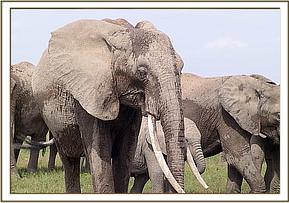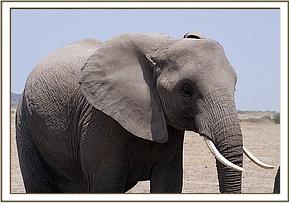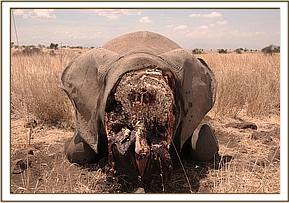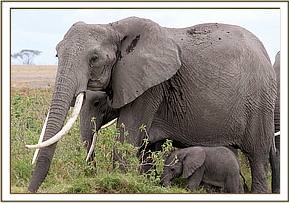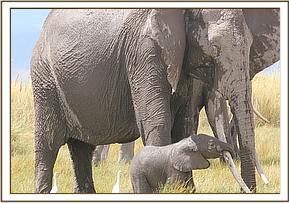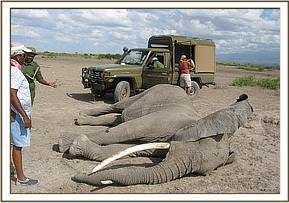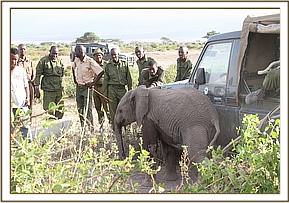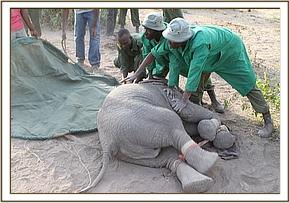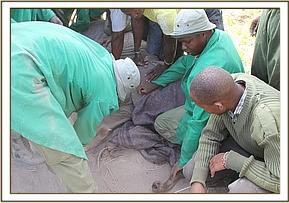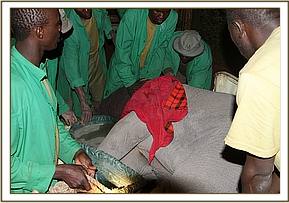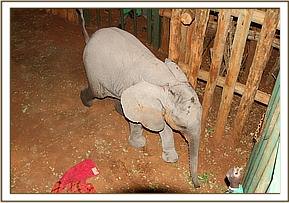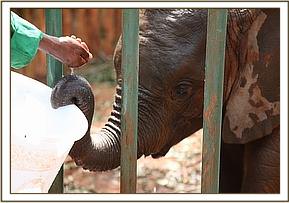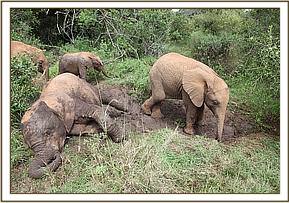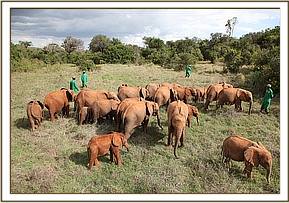












Now living wild, though she remains an integral part of our Umani herd
Current age
14 years old
Gender
Female
Rescued date
30 October 2012
Rescue location
Amboseli Ecosystem, Lemomo Area
Date of birth (estimate)
12 October 2011
Reason orphaned
Poaching
Age at rescue
12 months old (approx)
Current location
Umani Springs Reintegration Unit
Traditionally Amboseli elephants migrate into the Kilimanjaro forests within Tanzania and have done so since time immemorial. This is an ancient migratory route firmly implanted within their mysterious genetic memory. The Amboseli population is the only elephant population in Africa where some elephant families remain naturally intact, led by old, wise matriarchs, such as Qumquat, many of whom carry sizeable tusks as do some of the old bulls, such as “Ezra” (who was also senselessly killed, not by Poachers, but by disgruntled Masai tribesmen demanding more of the tourist revenue from the Park.)
The famous matriarch known as Qumquat was born in 1968, and was one of Amboseli’s famously identifiable icons. Having been studied for years by the Amboseli Trust for Elephants, she and her family, just 24 hours previously, were photographed together by Big Life’s Nick Brandt, and they were calm and trusting of their human admirers. Quantina’s young first born calf of just six months old remains missing to this day, but fortunately Quanza, Qumquat’s latest calf, was spared.
Qumquat was the leader of the researchers’ Q Elephant family, who carried distinctive beautiful long, thin tusks, and who matured to become the leader of her family, keeping them safe for over 4 decades. Her baby, Quanza, born on the 12th October 2011 was the first to be born following the devastating drought of 2009, which took such a heavy toll on many other species as well. Her baby was given the name “Quanza”– the Swahili word for “first”.
Previously matriarch Qumquat had been successfully treated for gunshot wounds in March 2009 by Dr. David Ndeereh, then the KWS Veterinarian seconded to the Sheldrick Wildlife Trust’s Tsavo Mobile Veterinary Unit.
Dr. Cynthia Moss and her team of researchers have monitored the Amboseli elephant population over the past 40 years, meticulously recording all elephant “hatches, matches and dispatches”, following elephant lives thereafter so the Amboseli elephants have been the subject of numerous documentaries and films, which have brought world-wide acclaim to Kenya, not to mention the tourist revenue aspect. Their lives are followed by literally millions of caring people world-wide. The death of each and every one of their number is an appalling indictment on the evil Ivory Trade and the avaricious greed of humankind.
The brutal killing of the beautiful matriarch Qumquat is a very real loss to the world as a whole and the images of her mutilated face hacked in half by axes to dislodge her beautiful slender tusks, out of which to make a trinket, are particularly shocking.
The world needs to ponder the fact that it takes two years to make an elephant and only 9 months to make a man!
The appetite for ivory in Far Eastern Nations, and especially China, drives the current poaching epidemic and is decimating Africa’s priceless elephant herds. Once only the prerogative of the rich, today ivory is affordable to China’s wealthier masses who also now regard it as a status symbol, and because of this fewer than 400,000 elephants remain alive in Africa today. These numbers are falling rapidly. The Forest Elephants of Central Africa are nearing total annihilation, and many former Elephant Range States have been left with none at all!
What will the International Convention for Trade in Endangered Species (CITES) do to stop this madness when the parties meet again in Thailand next year? Will they vote to ban all ivory and save the elephants, or will they again vote for the greed for money driven by trade which has fuelled the current slaughter.
Qumquat’s baby, Quanza, was still standing beside her dead mother when this horrific poaching incident was investigated. She was located and captured during the afternoon of the 30th October 2012 and flown back to the Nairobi Nursery that evening, arriving after dark, still in good health, but understandably very traumatized and “wild”, understanding full well who murdered her elephant mother and other family members. She probably even witnessed her mother’s face hacked in half and her beautiful long thin tusks being carried off by the thugs who shot her loved ones.
It took a few days for her to understand that not all humans are evil, and in this she has been helped by the other 25 Nursery elephant orphans who have been through the same loss, not least little “albino” Amboseli baby, “Faraja” who will impart to her the knowledge that she is fortunate to be amongst those few who have been rescued and who have found an alternative family and given a second chance of life. No elephant orphaned under the age of 3 years can live without access to milk unless conditions are extremely favorable.
Some of those involved in the killing of Qumquat and her family have been arrested with the help of the community of Big Life, and unbelievably the culprit had been arrested a year before and released. When will the sentencing fit the crime, and in this case the loss of such an irreplaceable icon. Deterrent sentencing can go a long way to helping the situation and we sincerely hope this man will be made an example of what happens to those that rob this country of such a priceless asset - Qumquat and her daughters.
We take small comfort in the fact that her genes live on through Quanza and thank all those involved in her safe rescue.
Traditionally Amboseli elephants migrate into the Kilimanjaro forests within Tanzania and have done so since time immemorial. This is an ancient migratory route firmly implanted within their mysterious genetic memory. The Amboseli population is the only elephant population in Africa where some elephant families remain naturally intact, led by old, wise matriarchs, such as Qumquat, many of whom carry sizeable tusks as do some of the old bulls, such as “Ezra” (who was also senselessly killed, not by Poachers, but by disgruntled Masai tribesmen demanding more of the tourist revenue from the Park.)

View diary updates from across all our orphan units as written by the Keepers

Our extended elephant family continues to grow! Zongoloni has given birth to a beautiful baby boy — her first calf and our fourth Umani grandchild.
By adopting, you play a vital role in the life of an orphaned elephant, rhino, or giraffe — helping us provide the round-the-clock, loving attention each one needs and deserves over many years, so they can ultimately reclaim their place in the wild.
Your adoption supports the 100+ orphans in our care at any given time, covering the cost of milk and food supplies, Keepers' salaries, veterinary treatment, and other essentials.

Celebrate your adoption with a personalised certificate, ready for you or your lucky gift recipient to print and display!

Each month, we send a detailed update about our Orphans’ Project direct to your email inbox, featuring photos, stories, and special highlights.

From the latest Keepers’ Diaries to a downloadable image gallery and more, adopters have exclusive access to our content library.
